Complete Solutions to MCQ & Solution of chapter FLUID MECHANICS of Class 12 book with complete answers and questions
| Class 12 | PHYSICS |
| Chapter | FLUID MECHANICS |
| BANSAL | MCQ & Solution |
| Number Of Questions | 86 |
| Academic Year | 2023-24 |
A bucket water filled upto a height = 15 cm. The bucket is tied to a rope which is passed over a frictionless light pulley and the other end of the rope is tied to a weight of mass which is half of that of the (bucket + water). The water pressure above atmospheric pressure at the bottom is
03:26View SolutionA cone of radius `R` and height `H`, is hanging inside a liquid of density `rho` by means of a string as shown in figure. The force due to the liquid acting on the slant surface of the cone is
 05:31View Solution
05:31View SolutionThe area of cross-section of the wider tube shown in fig., is `800cm^(2)` . If a mass of 12 kg is placed on the massless piston, what is the difference in the level of water in two tubes.
 03:09View Solution
03:09View SolutionAn open cubical tank was initially fully filled with water. When the tank was accelerated on a horizontal plane along one of its side it was found that one thrid of volume of water was spilled out. The acceleration was
05:35View SolutionSome liquid is filled in a cylindrical vessel of radius R. Let `F_(1)` be the force applied by the liquid on the bottom of the cylinder. Now the same liquid is poured into a vessel of uniform square cross-section of side R. Let `F_(2)` be the force applied by the liquid on the bottom of this new vessel. (Neglect atmosphere pressure). Then
01:27View SolutionA liquid of mass 1 kg is filled in a flask as shown in figure. The force exerted by the flask on the liquid is `(g=10m//s^(2))` [Neglect atmospheric pressure]:
 01:30View Solution
01:30View SolutionA U-tube having horizontal arm of length 20 cm, has uniform cross-sectional area`=1cm^(2)`, It is filled with water of volume 60 cc. What volume of a liquid of density `4g//cc` should be poured from one side into the U-tube so that no water is left in the horizontal arm of the tube?
04:05View SolutionA light semi cylindrical gate of radius R is pivoted aat its mid point O, of radius R as shown in the figure holding liquid of density `rho`. The force F required to prevent the rotation of the gate is equal to
 02:08View Solution
02:08View SolutionThe pressure at the bottom of an open tank of water is 3p where p is the atmospheric pressure. If the water is drawn out till the level of water remains one fifth, the pressure at the bottom of the tank will now be
02:01View SolutionAn open -ended U-tube of uniform cross-sectional area contains water (density `1.0 g//cm^(23)`) standing initially 20 cm from the bottom in each arm. An immiscible liquid of density `4.0 g//cm^(2)` is added to one arm until a layer 5 cm high forms, as shown in the figure above. What is the ratio `h_(2)//h_(1)` of the heights of the liquid in the two arms ?
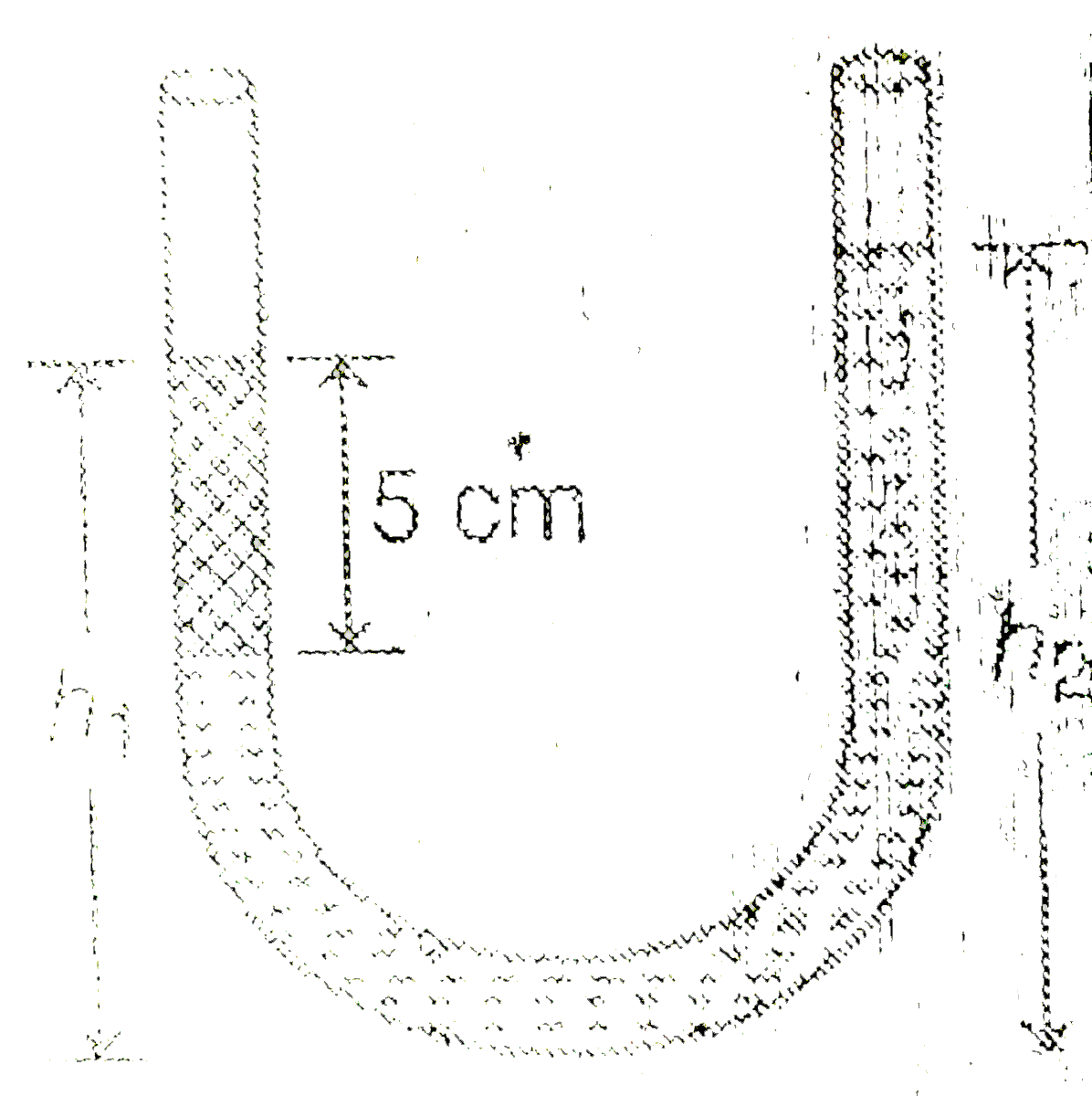 02:22View Solution
02:22View Solution
A cone of radius r and height r is under a liquid of density d.its base is parallel to the free surface of the liquid at a depth H from it as shown.What is the net force due to liquid on its curved surface? (neglect atmospheric pressure)02:34View SolutionTwo cubes of side 1.0 msides, one of relative density 0.60 and another of relative density `=1.15` are connected by weightless wire and placed in a large tank of water. Under equilibrium the lighter cube will project above the water surface to a height of
05:31View SolutionA cuboidal piece of wood has dimensions a, b and c. its relatively density is d. it is floating in a large body of water such that side a is vertical. It is pushed down a bit and released. The time period of SHM executed by it is
05:39View SolutionA uniform rod of length b capable of tuning about its end which is out of water, rests inclined to the vertical. If its specific gravity is 5/9, find the length immersed in water.
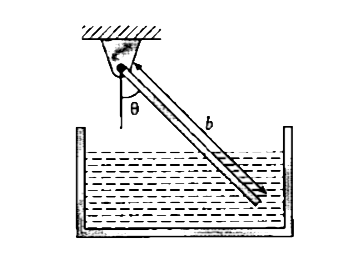 07:12View Solution
07:12View SolutionA dumbbell is placed in water of density `rho`. It is observed that by attaching a mass `m` to the rod, the dumbbell floats with the rod horizontal on the surface of water and each sphere exactly half submerged as shown in the figure. The volume of the mass `m` is negligible. The value of length `l` is
 08:37View Solution
08:37View SolutionTwo bodies having volumes V and 2V are suspended from the two arms of a common balance and they are found to balance each other. If larger body is immersed in oil (density `d_(1)=0.9gm//cm^(3)`) and the smaller body is immersed in an unknown liquid, then the balance remain in equilibrium. The density of unknown liquid is given by :
01:48View SolutionA container of large surface area is filled with liquid of density `rho`. A cubical block of side edge a and mass M is floating in it with four-fifth of its volume submerged. If a coin of mass m is placed gently on the top surface of the block is just submerged. M is
02:09View SolutionA boy carries a fish in one hand and a bucket (not full) of water in the other hand. If he places the fish in the bucket, the weight now carried by him (assume that water does not spill).
01:29View SolutionA cork of density `0.5gcm^(-3)` floats on a calm swimming pool. The fraction of the cork's volume which is under water is
03:00View SolutionA cylindrical block of length 2l is made of two different materials. The upper half has density `d_(1)` and and lower half, which is heavier, has density `d_(2)` the block is floating in a liquid of unknown density d with `(l)/(2)` of its length outside the liquid.
(a) Find d
(b) Show that `dgt(4d_(1))/(3)`
 02:53View Solution
02:53View SolutionThe frequency of a sonometer wire is f . When the weight producting the tensions are completely. Immersed in water the frequency becomes `f//2` and on immersing the weight in acertain liquid the fequency becomes `f//3`. The specific gravity of the liquid is
04:40View SolutionA ball of relative density 0.8 falls into water from a height of 2 m. The depth to which the ball will sink is (neglect viscous forces)
03:35View SolutionA small wooden ball of density `rho` is immersed in water of density `sigma` to depth h and then released. The height H above the surface of water up to which the ball will jump out of water is
02:18View SolutionA hollow sphere of mass M and radius r is immersed in a tank of water (denstiy `rho_(w)`). The sphere would float if it were set free. The sphere is tied to the bottom of the tank by two wires which makes angle `45^(@)` with the horizontal as shown in the figure. The tension `T_(1)` in the wire is :
 02:07View Solution
02:07View SolutionA sphere of radius R and made of material of relative density `sigma` has a concentric cavit of radius r. It just floats when placed in a tank full of water. The value of the ratio `R//r` will be
02:05View SolutionA body having volume V and density `rho` is attached to the bottom of a container as shown. Density of the liquid is `d(gtrho)`. Container has a constant upward acceleration a. Tension in the string is
 02:15View Solution
02:15View SolutionA beaker containing water is placed on the platform of a spring balance. The balance reads `1.5 kg.` A stone of mass `0.5 kg` and density `10^(4) kg//m^(3)` is immersed in water without touching the walls of the beaker. What will be the balance reading now?
03:06View SolutionThere is a metal cube inside a block of ice which is floating on the surface of water. The ice melts completely and metal falls in the water. Water level in the container
 04:51View Solution
04:51View Solution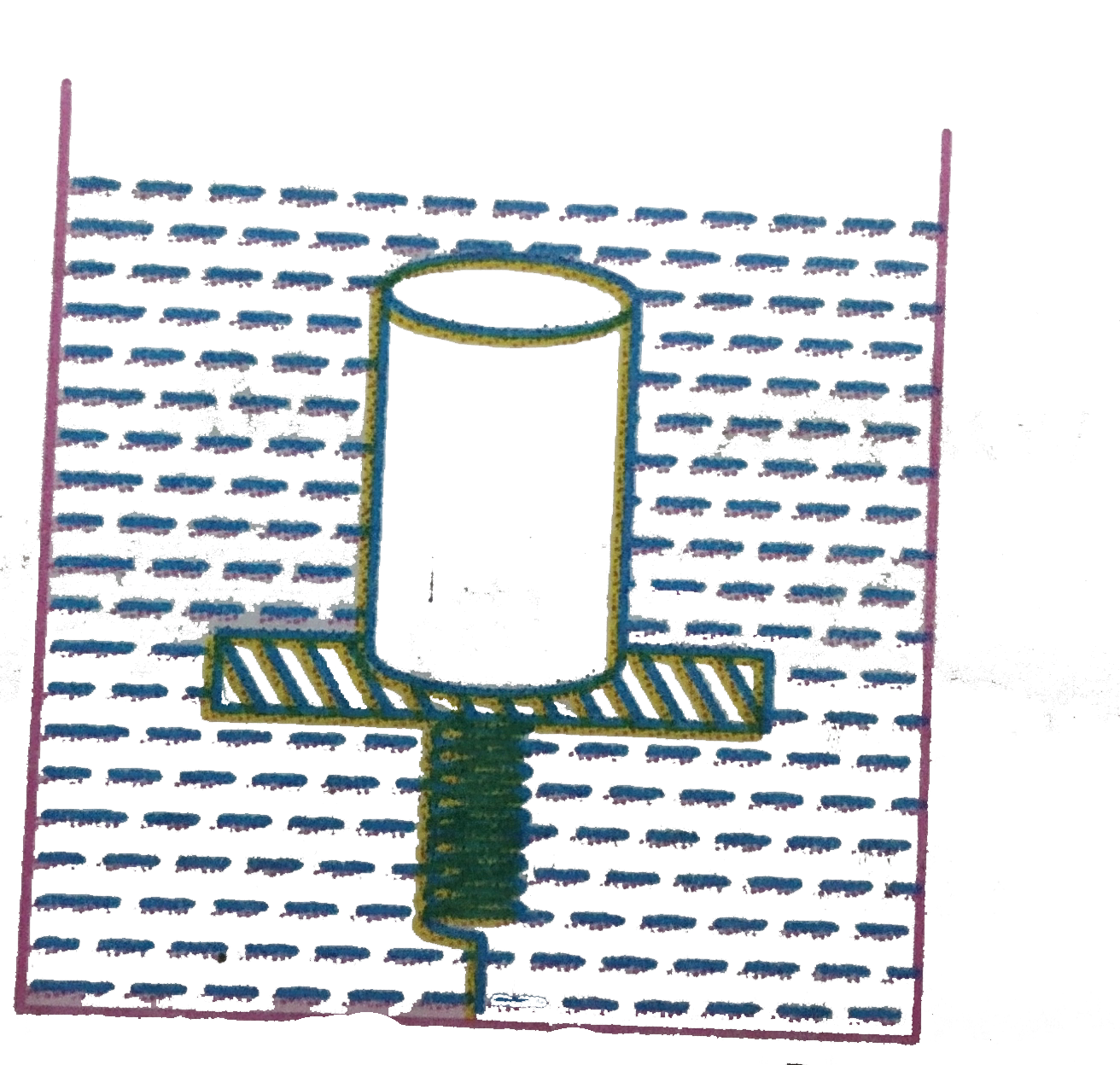
Cylindrical block of area of cross-section A and of material of density `rho` is placed in a liquid of density one third of density of block. The block compress in the spring is one-third of the length of the block. if acceleration due to gravity is g, the spring constant of the spring is02:08View SolutionA jet of water with cross section of `6 cm^(2)` strikes a wall at an angle of `60^(@)` to the normal and rebounds elastically from the wall without losing energy. If the velocity of the water in the jet is `12 m//s`, the force acting on the wall is
03:07View SolutionThe cross sectional area of a horizontal tube increases along its length linearly, as we move in the direction of flow. The variation of pressure, as we move along its length in the direction of flow (x-direction), is best depicted by which of the following graphs.
02:09View SolutionA square box of water has a small hole located the bottom corners. When the box is full and sitting on a level surface, complete opening of the hole results in a flow of water with a speed `v_(0)` as shown in Fig. (a). when the box is still half empty, it is tilted by `45^@` so that hole is at the lowest point. Now the water will flow out with a speed of
 02:56View Solution
02:56View SolutionWater is flowing steadily through a horizontal pipe of non-uniform cross-section. If the pressure of water is `4 xx 10^4 N//m^2` at a point where cross-section is `0.02 m^2` and velocity of flow is `2 m//s`. What is the pressure at a point where cross-section reduces to `0.01 m^2` ?
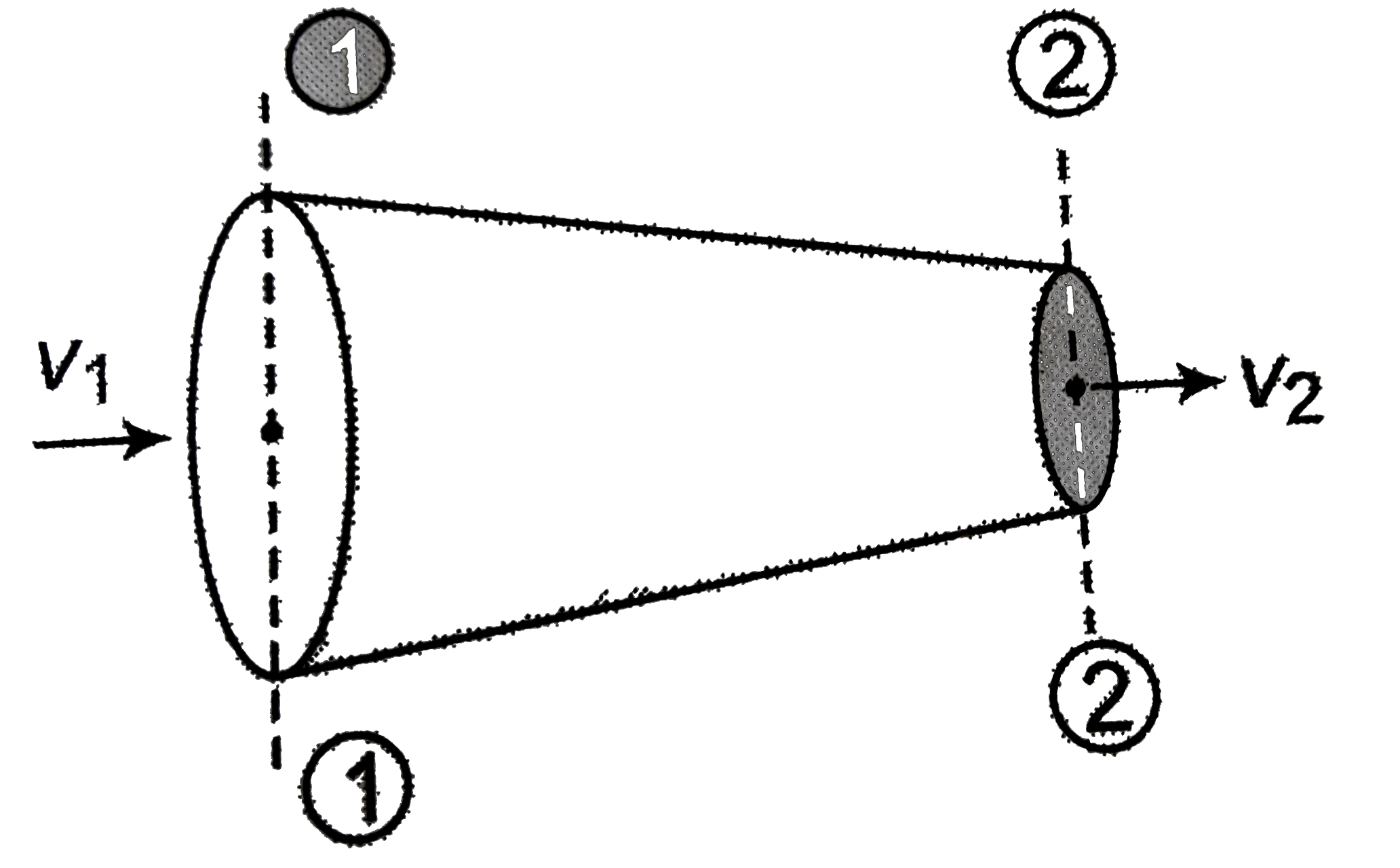 .04:09View Solution
.04:09View SolutionA tube is attached as shown in closed vessel containing water. The velocity of water coming out from a small hole is :
 01:48View Solution
01:48View SolutionA large tank is filled with water to a height `H`. A small hole is made at the base of the tank. It takes `T_(1)` time to decrease the height of water to `(H)/(eta) (eta gt 1)`, and it takes `T_(2)` times to take out the rest of water. If `T_(1) = T_(2)`, then the value of `eta` is
02:39View SolutionIn the case of a fluid, Bernoulli's theorem expresses the application of the principle of conservation of :
01:32View SolutionFountains usually seen in gardens are generated by a wide pipe with an enclosure at one end having many small holes. Consider one such fountain which is produced by a pipe of internal diameter 2 cm in which water flows at a rate `3ms^(-1)`. The enclosure has 100 holes each of diameter 0.05 cm. The velocity of water coming out of the hole ids `("in" ms^(-1))` :
01:52View SolutionA fire hydrant delivers water of density `rho` at a volume are `L`. The water travels vertically upward through the hydrant and then does `90^(@)` turn to emerge horizontally at speed `V`. The pipe and nozzle have uniform cross-section through out. The force exerted by the water on the corner of the hydrant is
 02:44View Solution
02:44View SolutionA vertical tank, open at the top, is filled with a liquid and rests on a smooth horizontal surface. A small hole is opened at the centre of one side of the tank. The area of cross-section of the tank is N times the area of the hole, where N is a large number. Neglect mass of the tank itself. The initial acceleration of the tank is
01:47View SolutionTwo water pipes `P` and `Q` having diameters `2 xx 10^(-2) m ` and `4 xx 10^(-2) m`, respectively, are joined in series with the main supply line of water. The velocity of water flowing in pipe `P` is
03:16View SolutionThe range of water flowing out of a small hole made at a depth `10 m` below water surface in a large tank is `R`. Find the extra pressure (in atm) applied on the water surface so that range becomes `2R`. Take `1atm=10^(5)Pa`.
 03:22View Solution
03:22View SolutionA sufficiently long closed organ pipe has a small hole at its bottom . Initially , the pipe is empty . Water is poured into the pipe at a constant rate . The fundamental frequency of the air column in the pipe
01:30View SolutionA water barrel stands on a table of height `h`. If a small holes is punched in the side of the barrel at its base, it is found that the resultant stream of water strikes the ground at a horizontal distance `R` from the table. What is the depth of water in the barrel?
03:21View SolutionA cyclinderical vessel of cross-sectional area `1000cm^(2)`, fitted with a frictonless piston of mass `10kg`, and filled with water completely. A small hole of cross-sectional area `10mm^(2)` is opened at a point `50cm` deep from the lower surface of the piston. The velocity of efflux from the hole will be
05:09View SolutionA rectangular tank is placed on a horizontal ground and is filled with water to a height H above the base. A small hole is made on one vertical side at a depth D below the level of the water in the tank. The distance x from the bottom of the tank at which the water jet from the tank will hit the ground is
01:59View SolutionEqual volume of two immiscible liquids of densities `rho` and `2rho` are filled in a vessel as shown in the figure. Two small holes are punched at depths `h//2` and `3h//2` from the surface of lighter liquid. If `v_(1)` and `v_(2)` are the velocities of efflux at these two holes, then `v_(1)//v_(2)` is
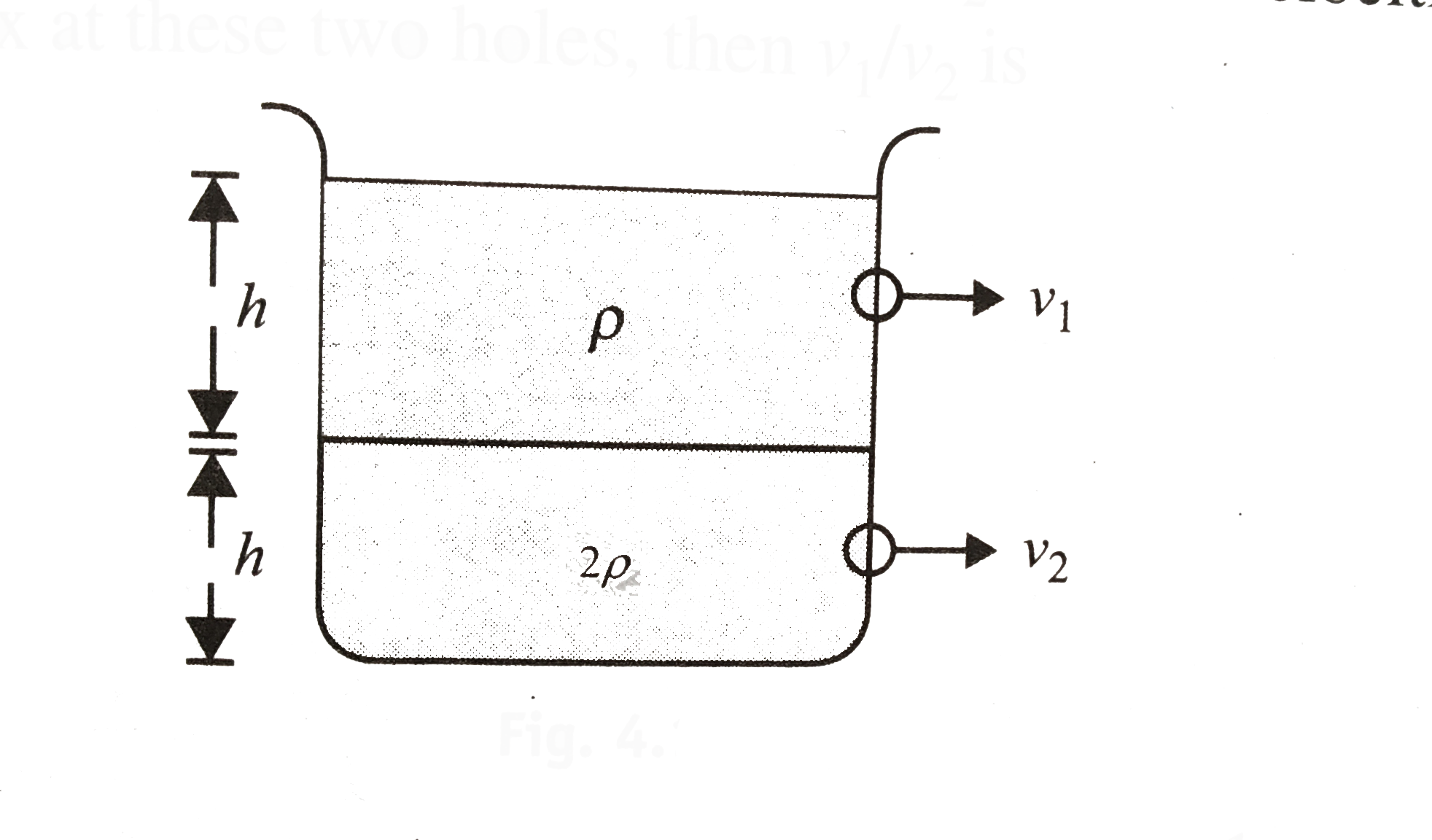 06:05View Solution
06:05View SolutionA horizontal pipeline carries water in a streamline flow. At a point along the tube where the cross sectional area is `10^(-2)(m^2)`, the water velcity is `2m//s` and the pressure is 8000Pa. The pressure of water at another point where cross sectional area is `0.5xx(10)^(-2)(m^2)` is
03:02View SolutionA cylindrical vessel filled with water upto a height of `2m` stands on horizontal plane. The side wall of the vessel has a pugged circular hole touching the bottom. If the minimum diameter of the hole so that the vessel begins to move on the floor if the plug is removed is `(x)/(10sqrt(pi))` meter then `x` will be (if the coefficient of frication between the bottom of the vessel and the plane is `0.4` and total mass of water plus vessel is `100 kg`.)
07:27View SolutionWhich of the following is not an assumption for an ideal fluid flow for which Bernoulli's principle is valid
01:35View SolutionA Newtonian fluid fills the clearance between a shaft and a sleeve. When a force of `800N` is applied to the shaft, parallel to the sleeve, the shaft attains a speed of `1.5cm//sec`. If a force of `2.4kN` is applied instead, the shaft would move with a speed of
04:07View SolutionA solid metallic sphere of radius r is allowed to fall freely through air. If the frictional resistance due to air is proportional to the cross-sectional area and to the square of the velocity, then the terminal velocity of the sphere is proportional to which of the following ?
01:42View SolutionTwo drops of same radius are falling through air with steady velocity of `v" "cm//s`. If the two drops coalesce, what would be the terminal velocity ?
01:48View Solution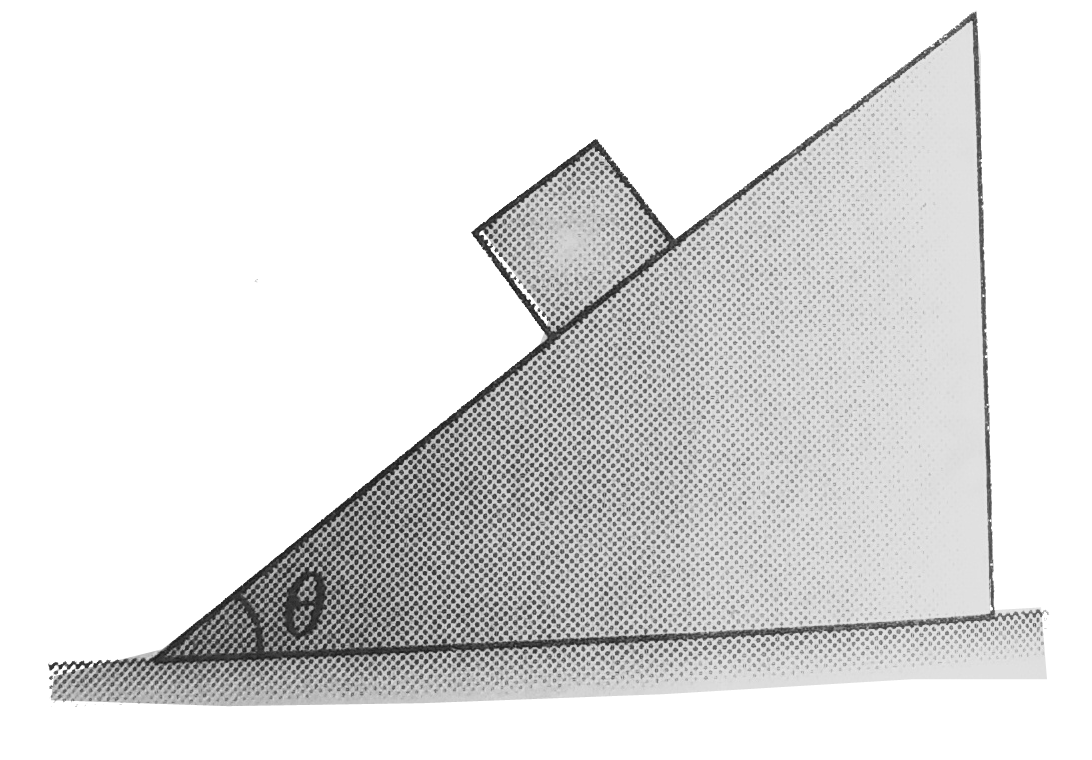
A cubical block of side `a` and density `rho` slides over a fixed inclined plane with constant velocity `v`. There is a thin film of viscous fluid of thickness `t` between the plane and the block. Then the coefficient of viscosity of the thin film will be: (Acceleration due to gravity is g)06:16View SolutionWhich of the following graphs best represents the motion of a raindrop?
02:15View SolutionWhich of the following is the incorrect graph for a sphere falling in a viscous liquid?
02:28View SolutionThe displacement of a ball falling rest in a viscous medium is platted against time. Choose a possible option
01:17View SolutionThere is a 1mm thick layer of glycerine between a flat plate of area `100cm^(2)` and and a big plate. If te coefficient of viscosity of glycerine is `1.0kg//m-sec`, then how much force is required to move the plate with a velocity of 7 cm/sec.
03:17View SolutionA container, whose bottom has round holes with diamter `0.1mm` is filled with water. The maximum height in cm upto which water can be filled without leakage will be what? Surface tension `=75xx10^(-3)N//m` and `g=10m//s^(2)`
01:49View SolutionIf two soap bubbles of different radii are connected by a tube
03:41View SolutionA liquid is filled in a spherical container of radius R up to a height `h`. At this position the liquid surface at the end is also horizontal. The contact angle is
 01:42View Solution
01:42View SolutionA capillary tube of radius r is placed in a liquid I the angle of contact is `theta` , the radius of curvature R of the meniscus in the capillary is
04:00View SolutionA beaker filled with water, is accelerated at a rate a `m/s^(2)` in forward direction. The surface of water shall make an angle
07:59View Solution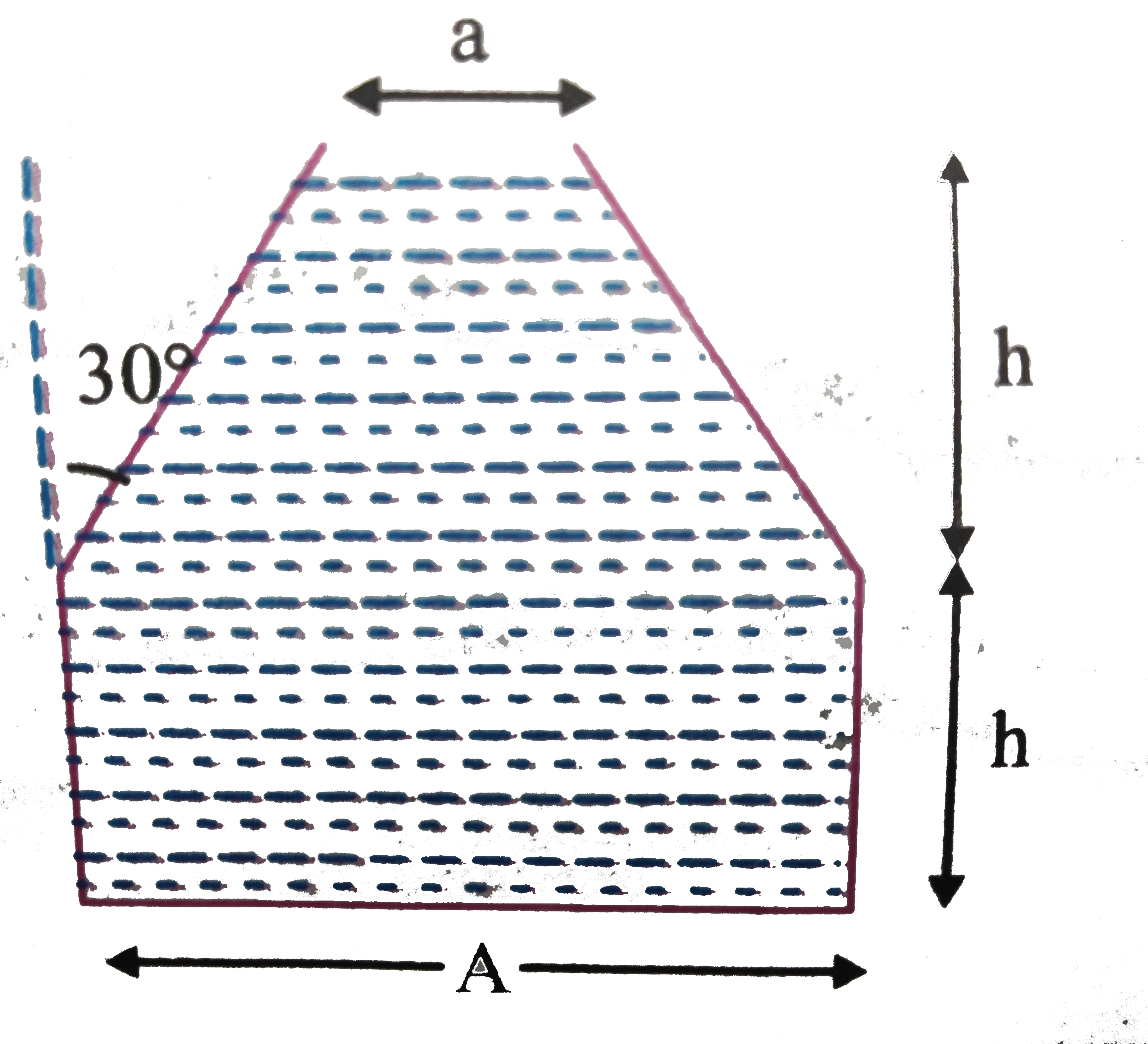
The vessel shown in the figure has two sections. The lower part is a rectangular vessel with area of cross-section A and height h. The upper part is a conical vessel of height h with base area A and top area `a` and the walls of the vessel are inclined at an angle `30^(@)` with he vertical.A liquid of density `rho` fills both the sections upto a height 2h. Neglect atmospheric pressure.04:19View SolutionA cubical block of wood of `10cm` and mass `0.92kg` floats on a tank of water with oil or rel. density `0.6`. Thickness of oil is `4cm` above water. When the block attains equilibrium with four of its sides edges verical:
06:05View SolutionThe spring balance A reads 2 kg with a block m suspended from it. A balance B reads 5kg when a beaker with liquid is put on the pan of the balance. The two balances are now so arranged that the hanging mass in inside the liquid in the beaker as shown in the figure. In this situation:
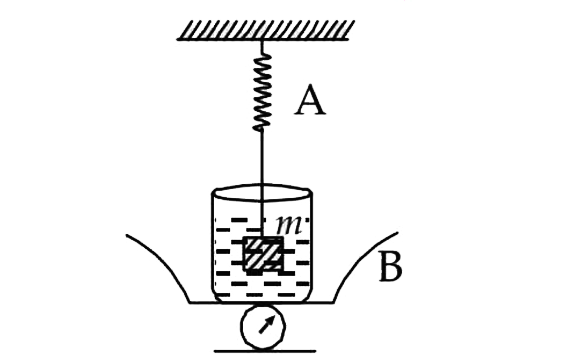 02:49View Solution
02:49View SolutionWhen an air bubble rise from the bottom of a deep lake to a point just below the water surface, the pressure of air inside the bubble
02:57View SolutionFigure shows a siphon. Choose the wrong statement.

(`p_(0)` = atmospheric pressure)03:29View SolutionA tank is filled upto a height h with a liquid and is placed on a platform of height h from the ground. To get maximum range `x_(m)` a small hole is punched at a distance of y from the free surface of the liquid. Then
 04:28View Solution
04:28View SolutionA horizontal jet of water coming out of a pipe of area of cross-section `20cm^(2)` hits a vertical wall with a velocity of `10ms^(-1)` and rebounds with the same speed. The force exerted by water on the wall is .
06:45View SolutionA steady flow of water passes along a horizontal tube from a wide section X to the narrower section Y, see figure. Manometers are placed at P and Q at the sections. Which of the statement A,B,C,D, E is most correct?
 01:46View Solution
01:46View SolutionSome question (Assertion-Reason type) are given below. Each question contains STATEMENT-1(Assertion) and STATEMENT-2(Reason) . Each question has 4 choices (A),(B),(C ) and (D) out of which ONLY ONE is correct. So select the correct choice :
STATEMENT-1
If a body is floating in a liquid, the density of liquid is always greater than the density of solid.
STATEMENT-2
Surface tension is the property of liquid surface.02:01View SolutionSome question (Assertion-Reason type) are given below. Each question contains STATEMENT-1(Assertion) and STATEMENT-2(Reason) . Each question has 4 choices (A),(B),(C ) and (D) out of which ONLY ONE is correct. So select the correct choice :
STATEMENT-1
Viscosity of liquid increases rapidly with the rise of temperature.
STATEMENT-2
Viscosity of liquid is the property of liquid by virtue of which it opposes the relative motion amongst its different layers.01:36View SolutionSome question (Assertion-Reason type) are given below. Each question contains STATEMENT-1(Assertion) and STATEMENT-2(Reason) . Each question has 4 choices (A),(B),(C ) and (D) out of which ONLY ONE is correct. So select the correct choice :
STATEMENT-1
Falling raindrops acquire a terminal velocity.
STATEMENT-2
A constant force in the direction of motion and a velocity dependent force opposite to the direction of motion, always result in the acquisition of terminal velocity.01:37View SolutionSome question (Assertion-Reason type) are given below. Each question contains STATEMENT-1(Assertion) and STATEMENT-2(Reason) . Each question has 4 choices (A),(B),(C ) and (D) out of which ONLY ONE is correct. So select the correct choice :
STATEMENT-1
In the steady flow of an ideal fluid, the velocity at any point is same for different fluid particles.
STATEMENT-2
Steady fluid flow is the unaccelerated fluid flow.01:44View SolutionSome questions (Assertion-Reason Type) are given below. Each question contains Statement I (Assertion) and statement II(reason). Each question has 4 choices (a),(b),(c ) and (d) out of which only one is correct. So select the correct choise.
a. Statement I is True, Statement II is True,Statement II is a correct explanation for Statement I
b. Statement I is True, Statement II is True, Statement II is NOT a correct ecplanation for Statement I
c. Statement I is True, Statement II is False .
d. Statement I is false, Statement II is True.
2. Statement:I Though light of a single frequency (monochromatic light) is incident on a metal, the energies of emitted photoelectrons are different.
Statement II: The energy of electrons just after they absorb photons incident on the metal surface may be lost in collision with other atoms in the metal before the electron is ejected out of the metal.03:02View SolutionSome question (Assertion-Reason type) are given below. Each question contains STATEMENT-1(Assertion) and STATEMENT-2(Reason) . Each question has 4 choices (A),(B),(C ) and (D) out of which ONLY ONE is correct. So select the correct choice :
STATEMENT-1
1kg of cotton fibre will weight less lens in air when made more fluffy.
STATEMENT-2
Weight of air in cotton will cancel out with the force of extra buoyancy acting on it.01:44View SolutionSome question (Assertion-Reason type) are given below. Each question contains STATEMENT-1(Assertion) and STATEMENT-2(Reason) . Each question has 4 choices (A),(B),(C ) and (D) out of which ONLY ONE is correct. So select the correct choice :
STATEMENT-1
Steel is more elastic than rubber.
STATEMENT-2
When same deformation is produced in two identical bodies of these material greater restoring force develops in the steel body.01:53View SolutionSome question (Assertion-Reason type) are given below. Each question contains STATEMENT-1(Assertion) and STATEMENT-2(Reason) . Each question has 4 choices (A),(B),(C ) and (D) out of which ONLY ONE is correct. So select the correct choice :
STATEMENT-1
Two identical beakers contains water to the same level. A wooden block is floating in one of the beakers. The total weight of both beakers is same.
STATEMENT-2
Volume of the displaced water is equal to the volume of the block.01:42View SolutionSome question (Assertion-Reason type) are given below. Each question contains STATEMENT-1(Assertion) and STATEMENT-2(Reason) . Each question has 4 choices (A),(B),(C ) and (D) out of which ONLY ONE is correct. So select the correct choice :
STATEMENT-1
A rain drop after falling through a certain distance attains a constant velocity.
STATEMENT-2
The viscous force for spherical body is proportional to its speed. Hence after falling through a certain distance viscous drag and buoyant forces balance the gravitational force.02:05View SolutionStatement-1: As wind flows left to right and a ball is spinned as shown, there will be a lift of the ball.
Statement-2: Decrease in velocity of air below the ball, increases the pressure more than that above the ball.
_E01_150_Q01.png) 02:44View Solution
02:44View SolutionSome question (Assertion-Reason type) are given below. Each question contains STATEMENT-1(Assertion) and STATEMENT-2(Reason) . Each question has 4 choices (A),(B),(C ) and (D) out of which ONLY ONE is correct. So select the correct choice :
STATEMENT-1 : Ratio of normal stress to volumetric strain is bulk modulus of given gas.
STATEMENT-2 : Compressibility is the reciprocal of bulk modulus.01:48View SolutionStatement I: In the three cases shown in the figure, force exerted by liquid on three vessels is the same.
Statement II: Pressure at the bottom in each case is same.
 03:08View Solution
03:08View SolutionStatement-1: A block is immersed in a liquid inside a beaker which is falling freely buoyant force acting on block is zero.
Statement-2: In case of freely falling liquid there is no pressure difference between any two points._E01_151_Q01.png) 02:01View Solution
02:01View SolutionSome question (Assertion-Reason type) are given below. Each question contains STATEMENT-1(Assertion) and STATEMENT-2(Reason) . Each question has 4 choices (A),(B),(C ) and (D) out of which ONLY ONE is correct. So select the correct choice :
STATEMENT-1 : The velocity increase, when water flowing in broader pipe enter a narrow pipe.
STATEMENT-2 : According to equation of continuity, product of area and velocity is constant.01:49View SolutionSome question (Assertion-Reason type) are given below. Each question contains STATEMENT-1(Assertion) and STATEMENT-2(Reason) . Each question has 4 choices (A),(B),(C ) and (D) out of which ONLY ONE is correct. So select the correct choice :
STATEMENT-1 : Pascal's Law is the working principle of a hydraulic lift.
STATEMENT-2 : Pressure is equal to thrust acting per unit area.01:42View SolutionSome question (Assertion-Reason type) are given below. Each question contains STATEMENT-1(Assertion) and STATEMENT-2(Reason) . Each question has 4 choices (A),(B),(C ) and (D) out of which ONLY ONE is correct. So select the correct choice :
STATEMENT-1 : Two row boats moving parallel to one another are pulled towards one another.
STATEMENT-2 : When the boats are close to each other, the velocity of water between them increases and pressure falls according to Bernoull's theorem.01:25View Solution
MCQ & Solution questions and complete solutions for chapter FLUID MECHANICS of BANSAL PHYSICS (HINGLISH) of Class 12
